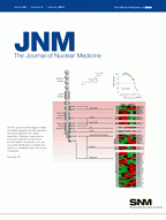TO THE EDITOR: With great interest we read the recent article by Cho et al. entitled “Substructural Hippocampal Glucose Metabolism Observed on PET/MRI” ( 1). In that work the authors performed high-resolution 18F-FDG PET and structural MRI of the hippocampus in a group of 5 healthy subjects. Among the hippocampal subfields, the highest 18F-FDG uptake was consistently found in the dentate gyrus and cornu ammonis (CA) 4. This report is the first such structural/functional study benefiting from the latest advances in spatial resolution and is therefore of special relevance. However, we wish to suggest an additional data analysis, which from our point of view is essential to implicitly address the issue raised by the authors, that is, substructural hippocampal glucose metabolism.
The hippocampus is a limbic region with a very complex anatomy and function. Based on the predominant cell type, cell origin, and connectivity, the hippocampus is typically segmented into the dentate gyrus; CA1, CA2, CA3, and CA4 fields; and subiculum. This organization, which roughly fits the horizontal axis of the structure, is considered fundamental to hippocampal function, and numerous studies have focused on the above cytoarchitectural subdivisions to explain functional specialization within the hippocampus. Growing evidence indicates, however, the presence of functional differentiation also along the longitudinal, or anteroposterior, axis of the hippocampus. This concept, initially based on animal data, has recently been supported by in vivo neuroimaging studies. Specifically, several investigators have reported a relationship between neuroimaging indices of the anterior hippocampus and episodic memory performance ( 2– 4).
As for 18F-FDG PET, Ouchi et al. ( 5) found glucose metabolism to be higher in the head than in the body or tail parts of the hippocampus in a group of 8 healthy subjects (mean age of 58 y). In contrast, patients with pure amnesia or with mild Alzheimer dementia showed significantly decreased metabolism in the hippocampal head only. The authors of that study suggested that the energy consumption subserving synaptic transmission through the perforant pathway was higher in the anterior hippocampus, so as to maintain appropriate cognitive functions such as episodic memory. They also claimed that metabolic depression in this region can cause the memory dysfunction seen in amnestic patients. Indeed, the principal input from multimodal association neocortical areas occurs mainly in the anterior parts of the hippocampus, through the perforant pathway arising in the entorhinal cortex. Integrity of the perforant path is a major prerequisite for normal memory function, such that disruption of this path, as occurs very early in the course of Alzheimer disease, causes profound memory impairment ( 6).
Unfortunately, Cho et al. did not mention the age of their subjects. This is important, as the hippocampal subfields are differently prone to age-dependent processes ( 7), although the lack of atrophy in the MR images suggests that the subjects were relatively young. More importantly, the authors did not assess glucose metabolism along the longitudinal axis of the hippocampus, that is, separately for the hippocampal head, body, and tail. Such data would be of great interest for understanding the neurobiology of hippocampal function, as the rank order of metabolic rates might prove to be more distinct along the longitudinal axis of the hippocampus than along the horizontal axis investigated in the study.
Although hippocampal glucose metabolism has been already mapped by Ouchi et al. ( 5), the improved spatial resolution of the instrumentation possessed by Cho et al. presents distinct advantages. Specifically, the lesser effects of partial volume in the 18F-FDG images, and the nearly perfect coregistration afforded by the hybrid PET/MRI system, make their approach particularly appropriate for studying hippocampal metabolism at the substructural level.
- © 2011 by Society of Nuclear Medicine







